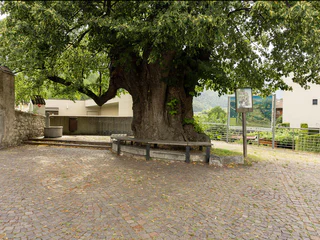
1/2
Old Linden Tree in Aicha
Aica/Aicha, Natz-Schabs/Naz-Sciaves, Brixen/Bressanone and environs
Zuid-Tirol is bijzonder rijk aan verhalen die zich slingeren rond geheime locaties en ongewone natuurlijke formaties. Bezienswaardigheden, zoals de heksenbankjes op de Alpe di Siusi/Seiser Alm, vertellen verhalen van heksen en koningen, terwijl krachtplekken, zoals de "Stoanerne Mandln" met meer dan honderd cairns of de oude ruïnes op de heuvel van Castelfeder, bezoekers uitnodigen om te ontspannen en diep adem te halen. Unieke natuurlijke formaties zoals de aardpiramides zijn plaatsen die een wandeling en verkenning waard zijn.

1/2
Aica/Aicha, Natz-Schabs/Naz-Sciaves, Brixen/Bressanone and environs

Monticolo/Montiggl, Eppan an der Weinstaße/Appiano sulla Strada del Vino, Alto Adige Wine Road

1/2
S.Cristina Gherdëina/S.Cristina Val Gardena/S.Cristina Gherdëina/St.Christina in Gröden, S.Crestina Gherdëina/Santa Cristina Val Gardana, Dolomites Region Val Gardena

1/3
Falzeben/Falzeben, Hafling/Avelengo, Meran/Merano and environs

1/2
Moso in Passiria/Moos in Passeier, Moos in Passeier/Moso in Passiria, Meran/Merano and environs

1/4
Predonico/Perdonig, Eppan an der Weinstaße/Appiano sulla Strada del Vino, Alto Adige Wine Road

Senale/U.L. Frau i.W., U.L.Frau i.W.-St. Felix/Senale-S.Felice, Meran/Merano and environs

1/4
Rio Lagundo/Aschbach, Algund/Lagundo, Meran/Merano and environs

1/5
S. Giacomo/St. Jakob - Val di Vizze/Pfitsch, Pfitsch/Val di Vizze, Sterzing/Vipiteno and environs

1/2
Predonico/Perdonig, Eppan an der Weinstaße/Appiano sulla Strada del Vino, Alto Adige Wine Road

Siusi/Seis, Kastelruth/Castelrotto, Dolomites Region Seiser Alm

1/2
Lasa/Laas, Laas/Lasa, Vinschgau/Val Venosta

1/3
Dobbiaco Nuova/Neutoblach, Toblach/Dobbiaco, Dolomites Region 3 Zinnen

Merano/Meran, Meran/Merano, Meran/Merano and environs

Collepietra/Steinegg, Karneid/Cornedo all'Isarco, Dolomites Region Eggental

1/2
Gomagoi/Gomagoi, Stilfs/Stelvio, Vinschgau/Val Venosta

Prati/Wiesen, Pfitsch/Val di Vizze, Sterzing/Vipiteno and environs

1/3
Siusi/Seis, Kastelruth/Castelrotto, Dolomites Region Seiser Alm

1/4
Solda/Sulden, Stilfs/Stelvio, Vinschgau/Val Venosta

Selva/Sëlva/Wolkenstein/Sëlva, Sëlva/Selva di Val Gardena, Dolomites Region Val Gardena

Solda/Sulden, Stilfs/Stelvio, Vinschgau/Val Venosta

1/2
Aschbach/Rio Lagundo, Algund/Lagundo, Meran/Merano and environs

Braies di Dentro/Innerprags, Prags/Braies, Dolomites Region 3 Zinnen

1/3
Vallelunga/Langtaufers, Graun im Vinschgau/Curon Venosta, Vinschgau/Val Venosta

Santa Valburga/St. Walburg, Ulten/Ultimo, Meran/Merano and environs

Senale/U.L. Frau i.W., U.L.Frau i.W.-St. Felix/Senale-S.Felice, Meran/Merano and environs

1/5
Vernago/Vernagt, Schnals/Senales, Vinschgau/Val Venosta

Dobbiaco Nuova/Neutoblach, Toblach/Dobbiaco, Dolomites Region 3 Zinnen

1/3
Resia/Reschen, Graun im Vinschgau/Curon Venosta, Vinschgau/Val Venosta

Gfrill/Cauria, Salorno/Salurn, Alto Adige Wine Road